This post may contain affiliate links. Read our disclosure policy.
Check out The Ultimate Guide to Chocolate Chip Cookies Part One, plus The Ultimate Guide to Chocolate Chip Cookies Part 2 and Ultimate Guide to Chocolate Chip Cookies Part 3!
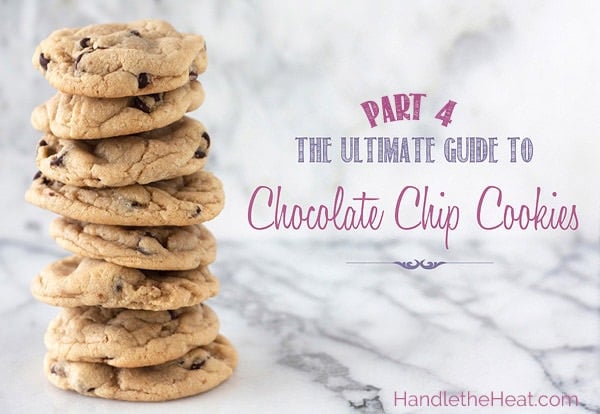
I’m doing a happy dance because today I’m sharing PART FOUR of my Ultimate Guide to Chocolate Chip Cookie series. I’ve received a lot of questions and comments about specific baking techniques and products and how they affect chocolate chip cookies. You guys wanted to know how oven temperature, creaming duration, baking surface, and baking pans affect cookies. Some people swear by certain techniques, while others unknowingly have problems with various products and methods. The below experimental batches will hopefully help you in troubleshooting why your cookies end up a certain way, whether that be flat, burned, underbaked, crisp, chewy, or whatever else!
I used an *adapted* version of the Nestle Tollhouse Chocolate Chip Cookie recipe as my control and made small variations among the baking methods and techniques to show you how they affect the cookie. I kept everything else the same in each recipe test so we could observe the differences in the finished cookie, photographing all the results for you. Together we’re on a journey to discover exactly how baking recipes work. See the comparison photos at the end of this post. Hopefully this will help you to discover why your cookies turn out the way they do and how to make YOUR version of the ultimate chocolate chip cookie!
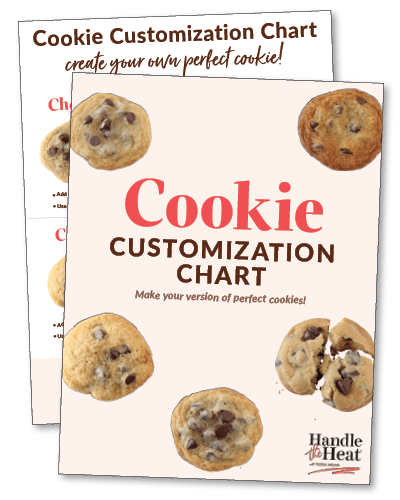
Free Cookie Customization Guide!
The science-based guide so you can bake perfect cookies every time!
Tools and Ingredients Used (when applicable):
–Spring-Loaded Cookie Scoop (Medium or 1 1/2-Tablespoon size)
–Chicago Metallic sheet pans
–Escali Digital Food Scale
–KitchenAid 5-quart Stand Mixer
–Oven thermometer
–Unbleached parchment paper
-Gold Medal All-Purpose Flour
-Fine sea salt
-Light brown sugar
-Large eggs
-Unsalted butter at a cool room temperature
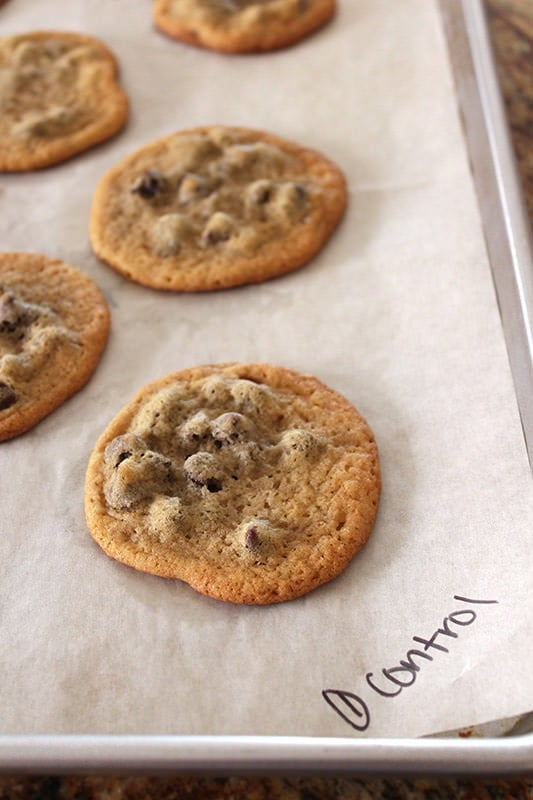
Ingredients:
1 cup plus 2 tablespoons (142 grams) all-purpose flour
1/2 teaspoon baking soda
1/2 teaspoon salt
1 stick (113 grams) unsalted butter, at room temperature
1/4 cup plus 2 tablespoons (75 grams) granulated sugar
1/4 cup plus 2 tablespoons (75 grams) packed light brown sugar
1/2 teaspoon vanilla
1 large egg
1 cup (170 grams) semi sweet chocolate chips
Directions:
Preheat oven to 350°F. Line baking sheets with nonstick baking mats or parchment paper.
In a medium bowl combine the flour, baking soda, and salt.
In the bowl of an electric mixer beat the butter, granulated sugar, and brown sugar until creamy, about 2 minutes. Add the egg and vanilla, beating well to combine. Gradually beat in the flour mixture. Stir in the chocolate chips. Scoop 1 1/2 tablespoon-sized balls and place onto prepared baking sheets.
Bake for 10 minutes, or until golden brown. Cool for 2 minutes before removing to wire racks to cool completely.
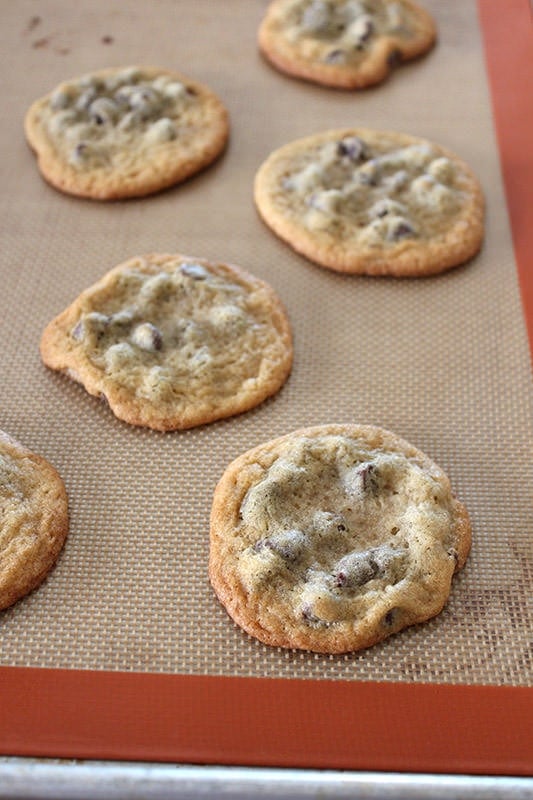
Silpat:
I received a few questions in my first Ultimate Guide to Chocolate Chip Cookies post about the effects of using parchment paper vs. a Silpat nonstick baking mat. Silpats are reusable non-stick baking mats often used in professional kitchens. I love my Silpats and have been baking with them for almost exclusively for so long that I never stopped to think how it might be affecting my baking products. I’ve heard some people claim their baked goods don’t become as browned and caramelized when using a Silpat, so I wanted to see if I experienced the same result in a side-by-side comparison with the control batch baked on standard parchment paper. The differences between the two batches were negligible, if anything the Silpat batch was slightly darker on the bottom and taller with a little less spread. I find these to be pleasant outcomes, so I will absolutely continue using my Silpat!
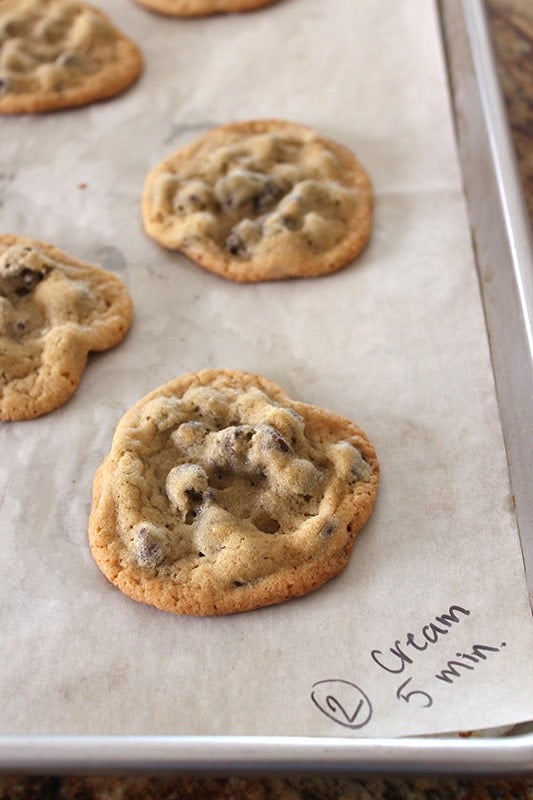
5 Minute Creaming:
This is something I think many people don’t pay attention to when baking cookies. In all my Ultimate Guide posts about chocolate chip cookies, my control recipe called for a specific 2 minutes of creaming. I counted those minutes exactly with a timer to ensure consistency and accuracy. I get a lot of questions from readers about cookies spreading too much in the oven. While many things can cause this, such as butter and/or dough that is too warm, overmixing butter can also lead to similar results.
The purpose of creaming the butter and sugar in a cookie recipe is to dissolve the sugar into the butter in a sense so the dough is homogeneous and bakes evenly. It also incorporates millions of tiny air bubbles into the batter, which in partnership with the leavener (baking soda in this case) helps to create a more airy, lifted texture. This is CRUCIAL when baking cake recipes which are intended to turn a dense batter into an ultra soft, tender, light, airy, and tall cake. Over-beating the butter in a cookie recipe, however, can cause the butter to warm too much and weaken its ability to hold air. Cookies just can’t become super tall and structured, so if the butter and sugar are over-beaten, they tend to spread and fall flat. I almost always call for 2 to 3 minutes of creaming time in an electric mixer on medium-high speed, this is usually enough time to homogenize the dough without risking over-beating. In this test batch, I creamed for exactly 5 minutes, an amount of time I felt might be easy for many home bakers to reach and over-cream without realizing. I wanted to see if this was enough creaming to negatively impact the cookies. The impact wasn’t huge, creaming longer would definitely exaggerate things. However, these cookies were certainly more pale, flat, soft, and light. They were also more misshapen, as though the butter was warm enough to melt out into whichever direction it wanted.
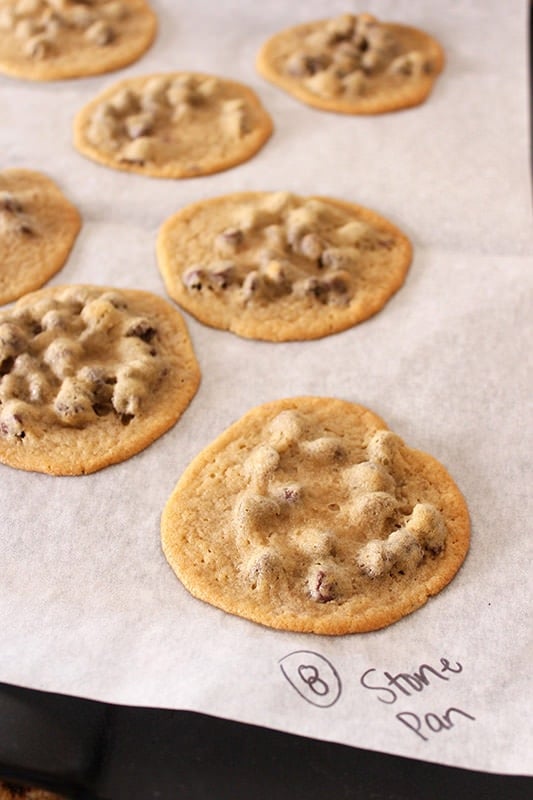
Stoneware:
I have received some comments from folks saying that they prefer to bake their cookies on stoneware. This made sense to me, as stoneware often heats more evenly than many metal baking sheets. I dropped the cookie dough onto parchment on my favorite Emile Henry baking stone which I use religiously for pizza. The stone was at room temperature and I placed it in a 350°F oven. I don’t know what happened, but whatever it was it was not good. The cookies turned into flat puddles with absolutely NO browning. They were completely under-baked, soft, and thin. They basically looked and tasted like melted cookie dough, not baked cookies. They were almost impossible to remove from the stone without having them fall apart. I was fairly shocked. I actually don’t think the tragedy behind these cookies is fully illustrated in the photos. If anything, I feared these cookies would be too brown. I don’t know if it was the dough recipe, the Tollhouse adaption is quite a wet dough, or if it was because I didn’t preheat the stone. Whatever it was I think I’ll avoid using stoneware for cookies altogether. They’re also more of a pain to lug out and to clean. I’d be curious to hear your thoughts on stoneware! Maybe I just used the wrong product or method. Either way, I thought the results might be useful or interesting to some of you.

375°F Baking Temperature
The original Nestle Tollhouse recipe is baked at 375°F. For all my Ultimate Guide experiments I switched the oven temperature to a more typical 350°F as my intention was to test out variations on the most average control cookie recipe. A few readers have pointed out this change in temperature, so I set out to test why the Tollhouse recipe would originally call for a higher baking temperature. I closely monitored my oven with an oven thermometer and once it reached 375°F I baked off a batch for exactly 10 minutes, like every other batch. A relatively small variance in temperature resulted in very different cookies. These chocolate chip cookies were much darker with a more crisp, crunchy texture. There was no ooey-gooey center whatsoever, however they did have a lovely depth of caramel-y flavor. I did enjoy these cookies, and I think I’ll bake off cookies at 375°F whenever I’m in the mood for that crisp texture.
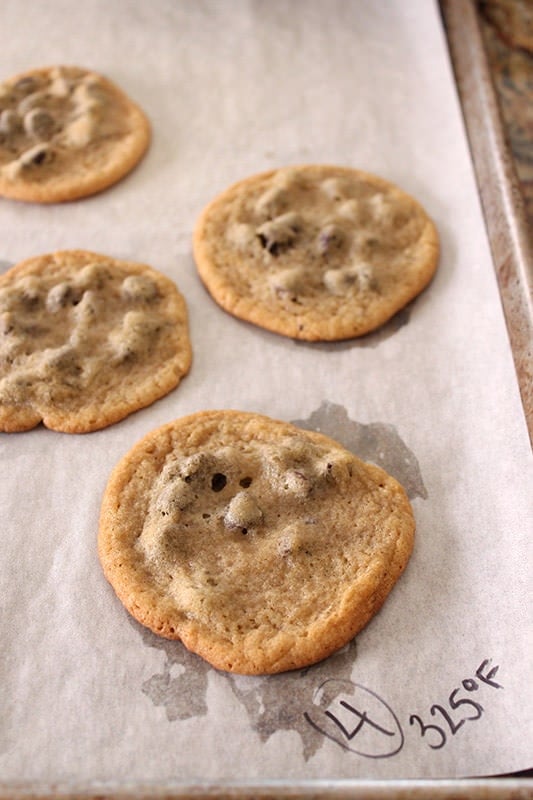
325°F Baking Temperature
On the flip side, I wanted to test out how dropping the oven temperature from 350°F to 325°F might affect the cookies. Dropping the temperature didn’t produce as different results as raising the temperature. These cookies were slightly softer with a chewy bite. The one thing they were noticeably lacking was that wonderful butterscotch, caramel-y flavor that chocolate chip cookies usually have. I don’t see why I’d use a lowered baking temperature again with chocolate chip cookies.
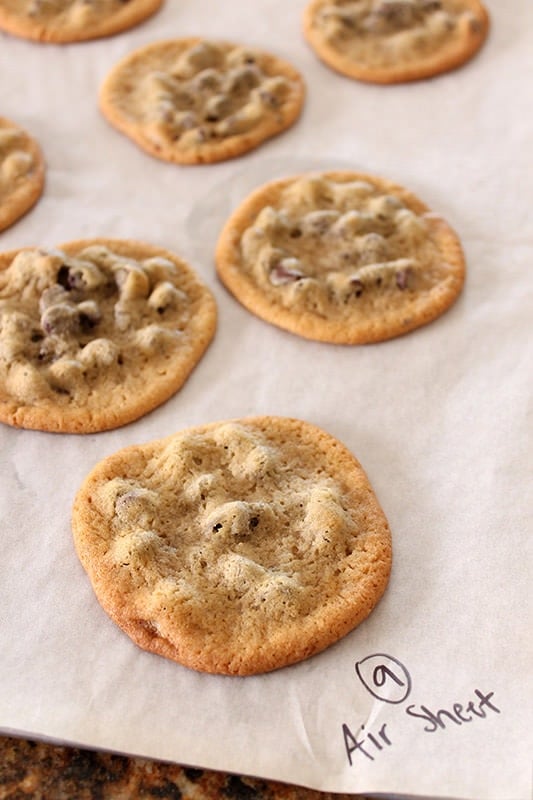
Air Baking Sheet
Another product that people seem to swear by are air baking sheets; baking sheets that are insulated and meant to prevent over-browning or burning. These cookies were flatter, perfectly round, with crisp edges. Unsurprisingly, the bottoms were not as brown as with the control recipe. I baked these for 10 minutes like I baked every other batch, but these cookies could have used another minute or two. I actually prefer more crisp, browned, caramelized cookies so I don’t think I’ll use insulated/Airbake sheets in the future.
Final Comparison:
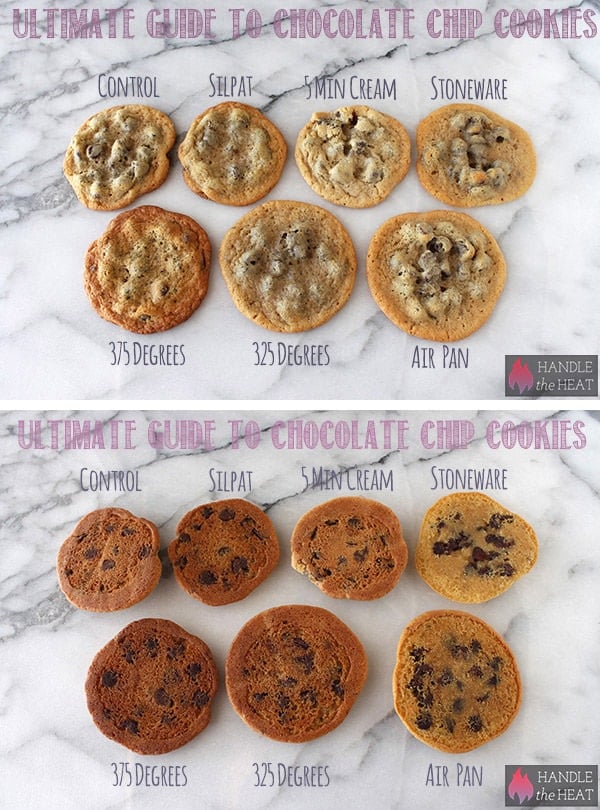
*If you use these images PLEASE give proper credit to me and link back to this post.*
All Four Guides in Comparison:
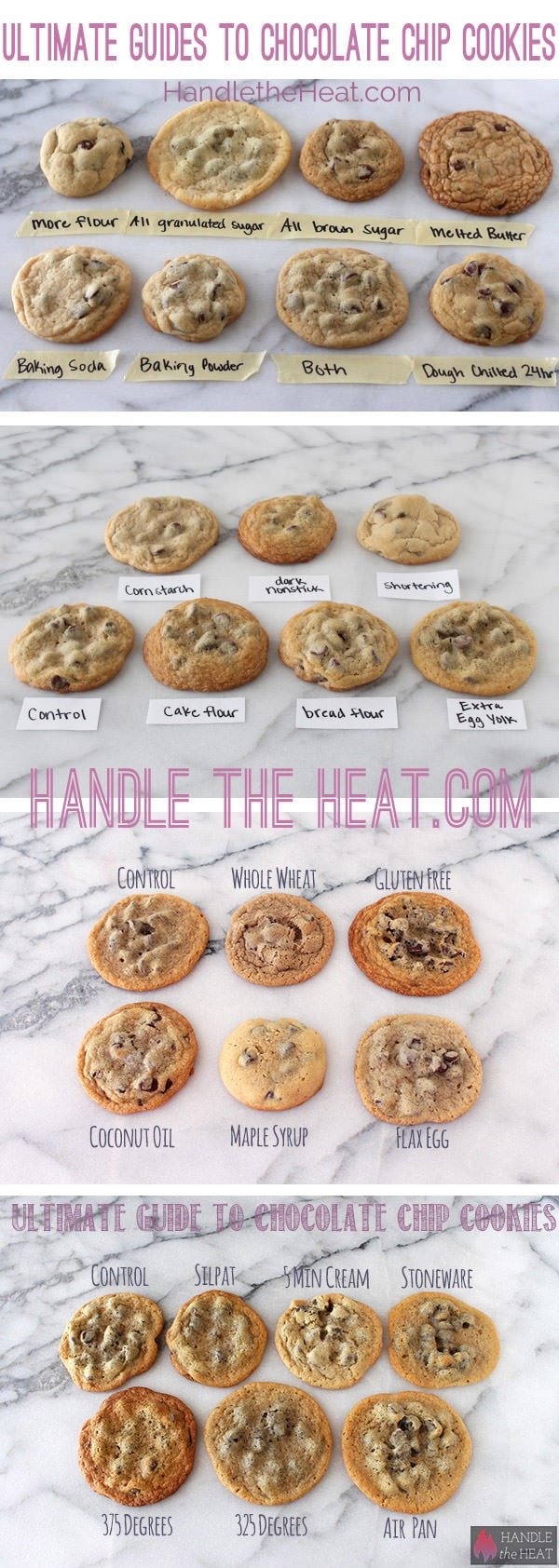

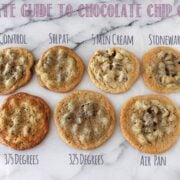

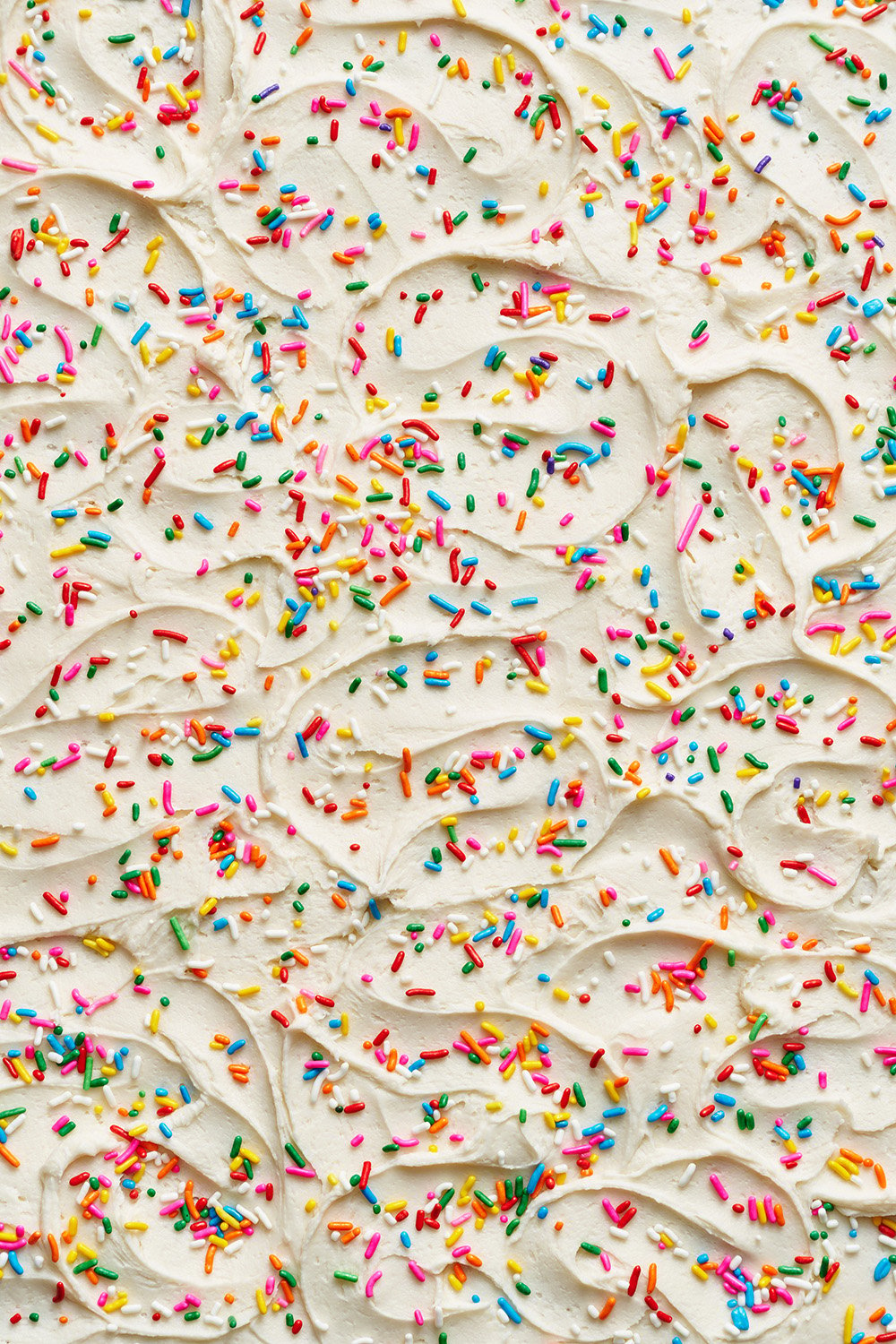
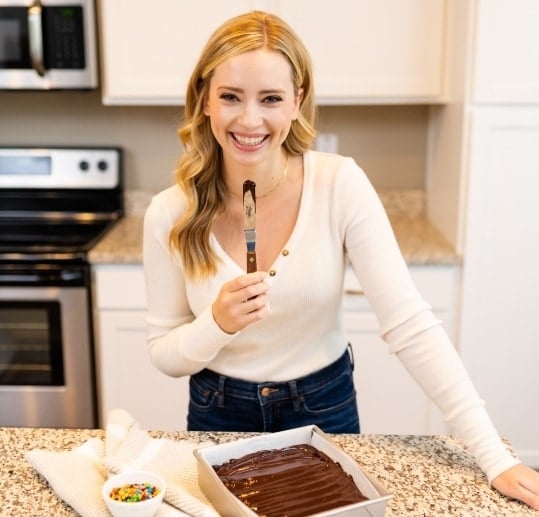

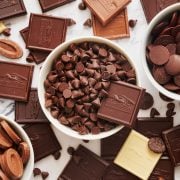
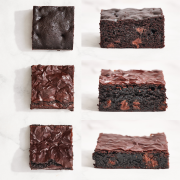
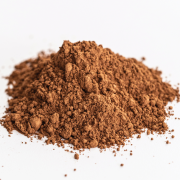
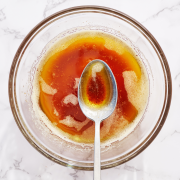

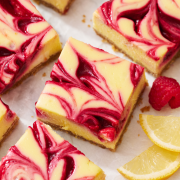

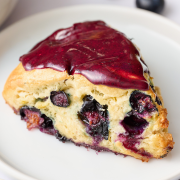








I think I’ll give it a try. Butter is just so fattening! I’m going to cut my regular recipe in half since I’m just experimenting.It calls for one flax egg.. Would it still work the same if it’s half a “flax egg ” ( so it’s 1/2 tablespoon flax and 1.5 tablespoon water..)? I’m new to baking. Thanks for helping me out!
Hmm… Maybe I’ll try the apple sauce instead. have you ever baked cookies with that? Or have you heard that it leaves an aftertaste?
No weird aftertaste if you use organic unsweetened, but like I said it’s really cakey.
Hey Tessa! So I’m vegan and have perfected the best chocolate chip cookies (did lots of experimenting!) but now I want to see if I can make them healthier by subbing the 1/2 cup of vegan butter (earth balance) with… Maybe a banana? Have you ever made chocolate chip cookies with bananas? Or apple sauce? I’m already using a flax egg so I can’t repeat that ingredient.
Please let me know! I’ve used your pictures while experimenting and they are very helpful! 🙂
Hi Heidi! I haven’t tried a banana, but I’ve heard it yield really awesome results (but with a banana aftertaste which could be a good or bad thing). Applesauce makes for a really cakey cookie. Let me know if you experiment with this and how it turns out 🙂
Man, I am so hungry for cookies right now! Just wondering if you’ve ever experimented with different quantities of butter? A friend in college always cut the amount of butter in the recipe in half. The result was a more mounded cookie (less spreading) that was chewier and a little more cake-y.
Interesting! Were they dry?
Loved this, thanks! I’ve tested many of these modifications myself. I’m most surprised by your stoneware results. I used to make cookies religiously on Silpats until I tried them on stoneware myself (directly on stone, no parchment paper). Now I haven’t used a Silpat for a few years. I do have to increase the cooking time, though, even with a warmed stone, and suspect that longer time is what was missing on your test. Using stoneware, my cookies are the exact same color on top and bottom.
OMGSH… I have been baking for…..12 years now and am just now reading this?! Your article should be mandated!!! Paula and Martha are slacking!!!
Thank you!
Hello,
Your control recipe looks different in some photos. For example, in the photo where you’re using the Silpat and Stoneware, your control cookie flattened with the chocolate chips protruduing. In the photo where you compared the extra flour, melted butter, etc., your control cookie (assume it’s the baking soda) is much thicker and lighter in color.
Why do you think this is?
I started my own experiments yesterday and was surprised at how my cookies looked different than yours. It made me wonder how humidity (I live in Atlanta.) and various ovens affect baking. I’m not sure if you touched on that in any of your blogs, but it seems important to mention.
Suffice it to say, it may be more accurate to call your “ultimate” cookie recipe “my kitchen’s ultimate” cookie recipe. 🙂 I think every kitchen produces a slightly different cookie, and everyone needs to do their own testing to find THEIR perfect recipe.
(Although….this still doesn’t help me figure out why your control cookies look different.)
I’d love for you, or anyone, to chime in!!!
Thanks,
Jennifer
I use stoneware all the time for baking and you aren’t supposed to ever use parchment on them! They still bake different though. You have to leave them on the stoneware to cool before removing. They will set up A LOT. Then they don’t fall apart. Also, they WILL brown on stoneware. I’m thinking your parchment kept that from happening or else you just didn’t bake them long enough. As another person said, it’s best to have two stones to alternate so you always have a cool one.
Wow! I can’t imagine how much time all of your testing takes. I tried two cake recipes this weekend to compare (egg yolks in one, egg whites in the other). I was in the kitchen for four hours. 🙂
You’ve done exactly what I’d like to do. Thanks!
I’m on a mission to find (or, perhaps create) a great choc. chip cookie recipe and a great cake recipe.
Thanks!
Jennifer
I use a Vollrath cookie sheet with Silpat. My cookies seem to turn out even better. Prev., I used a jelly roll pan, but losing the sides of the jelly roll seem to help get nicer cookies. Also, this recipe is delicious. Better than Tollhouse! Not an “eveyday cookie” by any standard. Worth a try.
http://bakerbynature.com/everyday-chocolate-chip-cookies/
This is for Gerry Eaton. Swans Down Cake Four is still being made. I saw it at Walmart today. It was on the shelf with the other flours. Its in a box. The box is shaped like a small, regular size cereal box. Today is Feb. 23, 2015. Just thought you would want to know.
Fab posts! My daughter and her friend started to work their way through the variations and then we lost the link… They’re back on the task now though 😀 Can I ask which variation is your favourite?